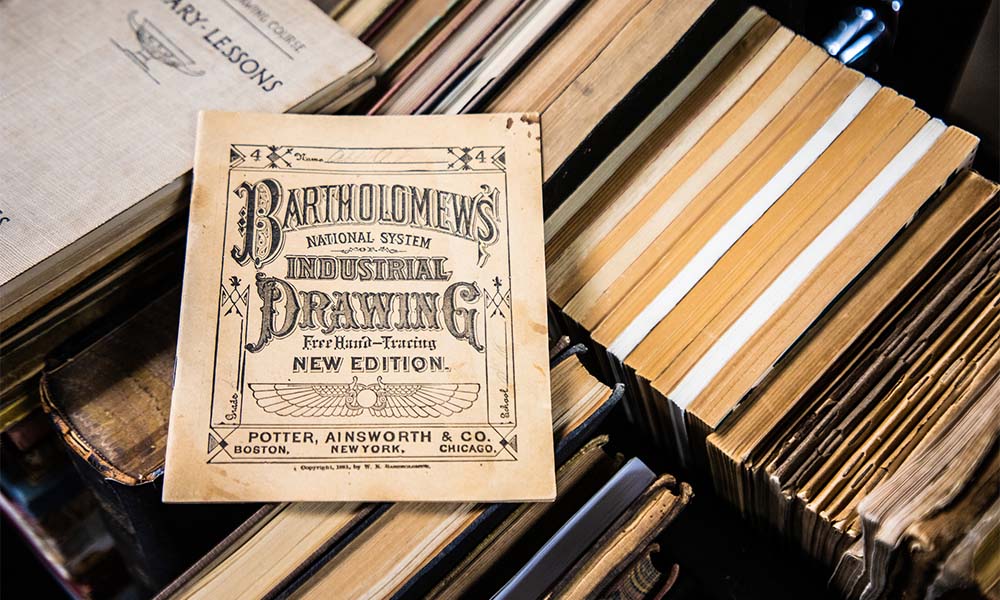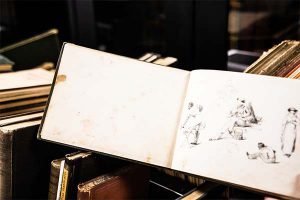
Concordia University Wisconsin now possesses a rare collection of art education books and manuals. Dr. Gaylund Stone is in the process of unpacking these historic materials.
Dr. Stone uncovers historic art education materials
What does an art education artifact look like? Dr. Gaylund Stone is in the process of unpacking and cataloguing historic art education materials. Concordia received a donation of nearly 2,000 art instruction books, with a special collection of about 800 drawing instruction books and manuals that date back to the early 19th Century. This collection, which Stone says is “likely the only collection of its type in existence,” can help us understand how our views of both art and education have changed over the years.

The donation was gifted to Concordia by Dr. David Baker, who was a professor and director of art education at UWM for years. Following his retirement from UWM, Baker joined the CUW faculty as an adjunct instructor within the graduate art education program. One of his main interests has always been in art education and the purpose of drawing, especially how children learn how to draw.
Stone himself is nearing retirement. After nearly 30 years at CUW, Stone will retire at the end of this academic year. He currently serves as a professor and department chair of art here at Concordia. He also previously served as the dean of the School of Arts and Sciences.
Below, Stone tells us about some of the art education artifacts he’s unpacking.
Tell us a little about these materials.
These manuals are ephemeral. Over the years, we managed to accumulate 800 volumes. They’re drawing manuals from the 1800s, specifically free-hand tracing. Some have some student work in them. There are even directions on how children should draw on slates and sidewalks, for example.
What’s the unpacking process like?
There are 41 boxes to unpack, and I’m about halfway through. Some of the materials are general artistry texts. Not all of the materials are historic, like the art education materials. But, they’re all related to industrial drawing. The materials directly relate to design and sending people off into the industries. We often think of art as expressive, but we don’t see that, really, until the 1900s.
Tell us about the uniqueness of the art education collection.

The idea is that we can make a digital collection here to archive and have available for educators. Dr. Baker has put together a monograph with a bibliography of books. In total, the piece is around 500 pages in draft form. Of course, it’s an annotated bibliography, unpublished, and it’s the property of the university.
My hope is to match what’s in the boxes, so I’m taking inventory based on what’s in the bibliography. These items will be housed in a cabinet that we have here on campus. They’ll be digitally scanned and stored in the rare books room.
Can you elaborate on the significance of these items?
Both viewing the collection and seeing the pieces are so important. They consist of tooled and stamped bindings, letter presses. All of this matters, and it really appeals to the physical sense. Books, historically, have always appealed to the sense of touch and the sense of sight. There is such beauty in the pages — it all matters.
What can this teach us about how people approach art?
Our sense of art is very much a 20th or 21st century point of view. For us, [art] is not just skill development. Today, we think of art as being expressive. But, it used to be viewed solely as skill development.
In the late 19th century – prior to this, everything was practical and design-focused. Art was not expressive ideas. The expressive piece dominates our talks now, but it wasn’t always that way.
Another important point is to note from looking at these things is how much was expected of young children early on. Even just the degree of precision and skill was impressive. Children were expected to do a lot of drawing work.
What does this tell us about art education?

Art education has never been about making artists. It’s teaching about using your senses. How to think. Historically, there has been a tremendous amount that has been done through drawing.
These older materials show us how education has directed children in particular paths. We learn the capabilities of children that we tend to underestimate. Our sense of what art is has very little to do with what it is historically. Our sense of free self-expression is misdirected. Art had a very different function in education, generally, and some of the earliest art education materials were for early childhood.
Do you want to know more?
If you’re interested in viewing the art education materials, contact Dr. Stone. If you’re wanting more information about life at Concordia University Wisconsin, visit us here.
—
If this story has inspired you, why not explore how you can help further Concordia's mission through giving.